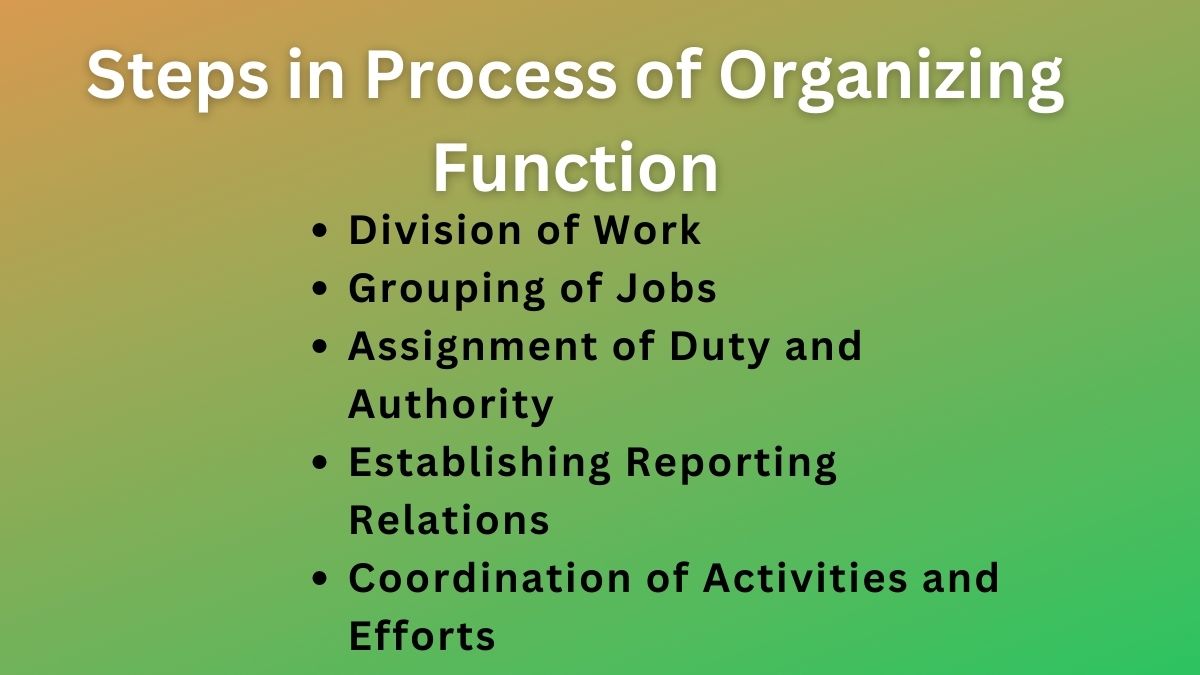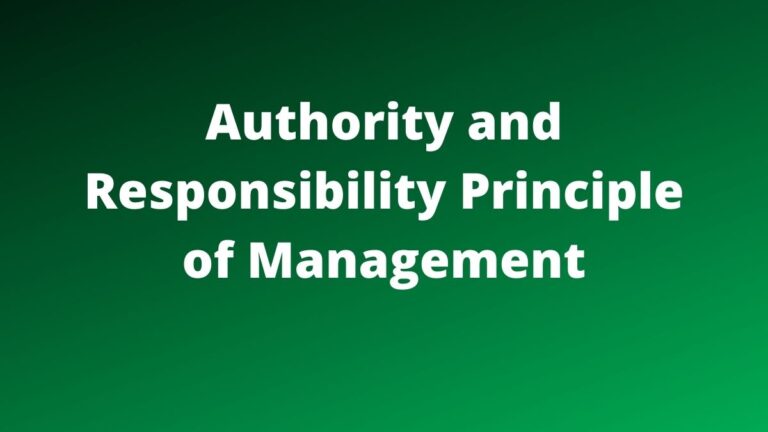5 Step Process of Organizing Function of Management
Process of Organizing
Organizing is the process of identifying the organization’s objectives and activities, grouping them, and ensuring proper coordination after the duties are assigned to employees to make the desired goals possible.
Organizing establishes a formal relationship among the employees so that they can perform their work jointly for the achievement of common objectives. It decides how to best group functions, responsibilities, and authorities.
Following are the fundamental steps in the organizing process that are persuaded to systematically and logically bind organizational activities and resources. The steps are:
Division of Work
The starting step in the process of organizing is the identification and division of work. The division of work is the process of breaking down a complex job into its many components to make it possible for every single task to be done with ease and effectiveness.
By this, employees are only assigned the specific task to perform. This reduces the duplication of work, and wastage of time, effort, and resources, and employee productivity is achieved.
Related: Division of Work Principle
Proper division of work gives the benefits of specialization. It includes giving the specific task to specific employees only that best matches his/her interest, knowledge, experience, and capability.
The main point to consider in the division of work process is that every complex job in the organization should be split in a way that the jobs would be done as effectively and efficiently as possible.
Grouping of Jobs
Once the activities are identified and jobs are divided, the next step in organizing is the grouping of jobs. Grouping of jobs includes a grouping of similar types of activities into units or departments logically. This process is also called departmentalization.
After the overall work of the organization is divided the works are grouped into different departments. For example, different departments may be production, marketing, finance, account, procurement, etc. These can be created on the basis of product, location, function, time to serve, customers, etc.
In all departments, different managers are appointed, called, departmental managers, and necessary subordinates to support the work. Each department manager is accountable for his department’s performance and all managers ultimately contribute to the overall objectives of the organization.
Assignment of Duty and Authority
After making various departments, the next task in the organizing process is the assignment of duties/works to different employees. For effectiveness in performance, it is essential to give certain authority along with the required duties to perform.
The allocation of responsibilities i.e. duties to employees should be based on their interests and working capacity. There must be a perfect match between employees’ capacity to perform the task and the nature or requirement of the task.
While assigning duties you should make sure that the right job is allocated to the right person. In addition, it is crucial to make sure that the right person also has the necessary authority to effectively execute the jobs on his/her end.
Related: Importance of Organizing
Every job should have a certain level of authority that will allow employees to make self-decisions during the course of the job. This acts as a source of inspiration to employees.
However, make sure that only the required authority should be given to job positions. Otherwise, the imbalance between jobs to be done and the authority to make decisions leads to misuse of power or underperformance.
Establishing Reporting Relations
After the duties are assigned to the right employees, it is necessary to clarify who needs to report to whom. Normally, in the organization, three levels of management are created and the lower-level or middle-level managers report to their subsequent upper level.
For example, an assistant marketing manager is required to report to the marketing manager rather than assisting the production manager. At the same time, the marketing manager needs to cooperate and coordinate with the production manager but should report to the general manager.
Such relationships are established in a vertically linear form which is called the chain of command. It is the clear and distinct line of authority among the positions in the organization. The scalar chain and unity of command are the two components of the chain of command.
Unity of command suggests that each person within an organization must have a clear reporting relationship to one and only one boss. The scalar principle suggests that there must be a clear and unbroken line of authority that extends from the lowest to the highest position in the organization.
Usually, the top-level manager is probably the only leader who is ultimately responsible for every decision, and all lower managers reach the top manager by reporting to their immediate superior.
Coordination of Activities and Efforts
The last step in the organizing process is the coordination of organizational activities and efforts in a way that ensures the achievement of desired objectives. The coordination process links the activities of every department in the organization.
Coordination of departmental efforts and output is necessary to boost organizational effectiveness and guarantee the achievement of organizational objectives. Limited resources can be best used to reduce the interdependency of departments.
The greater the interdependency more the coordination is required in the organization. For effective coordination, an effective communication channel must be established.
In the end, it should be noted that the goal of organizing is to make the organization ready to step on other management functions to achieve the goals and it ends with the proper placement of each organizational component that ensures the accomplishment of the goals.
Read Next: Principles of Organizing
Sajan Kushmi is a content writer with more than 4 years of experience. He holds BIM Degree. He write on the topics related to Management, Marketing, and Entrepreneurship.






